Kinases, a class of enzymes critical for cellular signaling, have emerged as attractive targets for drug development in various diseases. The design and development of selective kinase inhibitors have shown promise in treating cancer, autoimmune disorders, and other ailments. Among the wide array of kinase inhibitors, a specific class known as Type II kinase inhibitors has gained significant attention for their unique mode of action and therapeutic potential.
The Type II Kinase Inhibitors Library houses a collection of compounds that target the ATP-binding pocket of kinases, distinct from the well-studied Type I inhibitors. Unlike Type I inhibitors that bind to the active, kinase-conformational state, Type II inhibitors exploit the inactive, DFG-out conformation of kinases. This conformational selectivity allows Type II inhibitors to target kinases that are resistant to Type I inhibition and provides a new avenue for therapeutic intervention.
Type II kinase inhibitors exhibit several advantages over their Type I counterparts. Firstly, their unique binding mode allows for increased specificity, enabling researchers to selectively target specific kinases within a signaling pathway and minimize off-target effects. This selectivity is particularly beneficial in diseases where multiple kinases within a pathway need to be modulated. Additionally, Type II inhibitors can overcome acquired resistance to Type I inhibitors, making them an indispensable tool for tackling drug resistance in cancer and other diseases where kinase mutations render Type I inhibitors ineffective.
The Type II Kinase Inhibitors Library encompasses a diverse collection of compounds, offering researchers a broad range of options for exploring specific kinase targets. The library includes compounds with varying chemical structures, pharmacokinetic properties, and kinase selectivity profiles. This diversity allows researchers to identify lead compounds and optimize their chemical structures to enhance potency, selectivity, and drug-like properties.
The applications of the Type II Kinase Inhibitors Library are vast and extend to multiple disease areas. In cancer treatment, acquired resistance to Type I inhibitors often poses a significant challenge. However, Type II inhibitors have shown efficacy in overcoming this resistance by targeting specific mutations or altered kinase states that render Type I inhibitors ineffective. With the Type II Kinase Inhibitors Library, researchers can identify compounds that restore kinase inhibition and offer new treatment options for patients resistant to Type I inhibitors.
Beyond cancer, the Type II Kinase Inhibitors Library holds potential in addressing autoimmune disorders, neurodegenerative diseases, and other conditions where kinase dysregulation plays a role. By selectively targeting specific kinases known to be involved in disease pathology, researchers can explore the therapeutic potential of Type II inhibitors and develop innovative treatments.
Moreover, the Type II Kinase Inhibitors Library can serve as a valuable resource for drug discovery. Lead compounds identified from the library can be further optimized through structure-activity relationship studies and medicinal chemistry approaches, improving their potency, selectivity, and pharmacological properties. This optimization process, guided by the insights gained from the Type II Kinase Inhibitors Library, accelerates the development of novel compounds with enhanced therapeutic potential.
While the Type II Kinase Inhibitors Library offers significant promise, challenges remain in their development and application. Achieving selectivity for specific kinase targets can be difficult due to the structural similarities between various kinases. Additionally, off-target effects and potential toxicity need to be carefully addressed during the lead optimization process.
In conclusion, the Type II Kinase Inhibitors Library represents a groundbreaking advancement in the field of kinase inhibition. By targeting the ATP-binding pocket in the inactive state of kinases, Type II inhibitors offer unique opportunities for therapeutic intervention and overcoming acquired resistance. The diverse collection of compounds in the Type II Kinase Inhibitors Library opens new doors for research and drug discovery, providing scientists with tools to tackle challenging diseases and revolutionize the treatment landscape. Through continued exploration and optimization, Type II kinase inhibitors hold the potential to make a significant impact in the fight against various diseases.




